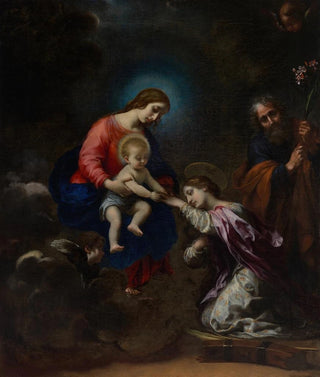Art print | The mystical marriage of Saint Catherine of Alexandria - Carlo Dolci Source: Reproduction | Le mariage mystique de sainte Catherine d'Alexandrie - Carlo Dolci


View from behind

Frame (optional)
Reproduction The Mystic Marriage of Saint Catherine of Alexandria - Carlo Dolci – Captivating Introduction
In the fascinating world of baroque art, "The Mystic Marriage of Saint Catherine of Alexandria" by Carlo Dolci emerges as an iconic work, captivating art enthusiasts with its spiritual depth and aesthetic beauty. This canvas, painted in the 17th century, depicts a pivotal moment in the life of Saint Catherine, an emblematic Christian figure often associated with wisdom and faith. Dolci, with his inimitable style, manages to convey an atmosphere of mystery and devotion, inviting the viewer to immerse themselves in a world where the sacred and the profane meet. The soft light bathing the scene enhances the intensity of the emotions, creating an intimate connection between the saint and the viewer.
Style and uniqueness of the work
Carlo Dolci's style is distinguished by remarkable meticulousness and delicacy. In "The Mystic Marriage of Saint Catherine of Alexandria," every detail, from the drapery of the garments to the expressions on the faces, is rendered with almost photographic precision. The use of warm colors and subtle contrasts gives the composition a depth that captivates the eye. The depiction of the saint, surrounded by symbolic elements such as the crown and the cross, demonstrates technical mastery that transcends simple realism. Dolci does not merely depict a religious scene; he creates an immersive experience, where the viewer is invited to feel the spirituality and solemnity of the moment. This unique approach makes the work a true masterpiece of baroque painting, where each brushstroke seems to vibrate with a life of its own.
The artist and his influence
Carlo Dolci, born in Florence in 1616, is considered one of the great masters of Italian painting. He managed to establish himself in an artistic context marked by figures such as Michelangelo and Raphael, while developing a personal style that is uniquely his own. His penchant for religious themes and his ability to capture human emotions made him a sought-after artist of his time. Dolci's works, often imbued with mysticism, have influenced

Matte finish

View from behind

Frame (optional)
Reproduction The Mystic Marriage of Saint Catherine of Alexandria - Carlo Dolci – Captivating Introduction
In the fascinating world of baroque art, "The Mystic Marriage of Saint Catherine of Alexandria" by Carlo Dolci emerges as an iconic work, captivating art enthusiasts with its spiritual depth and aesthetic beauty. This canvas, painted in the 17th century, depicts a pivotal moment in the life of Saint Catherine, an emblematic Christian figure often associated with wisdom and faith. Dolci, with his inimitable style, manages to convey an atmosphere of mystery and devotion, inviting the viewer to immerse themselves in a world where the sacred and the profane meet. The soft light bathing the scene enhances the intensity of the emotions, creating an intimate connection between the saint and the viewer.
Style and uniqueness of the work
Carlo Dolci's style is distinguished by remarkable meticulousness and delicacy. In "The Mystic Marriage of Saint Catherine of Alexandria," every detail, from the drapery of the garments to the expressions on the faces, is rendered with almost photographic precision. The use of warm colors and subtle contrasts gives the composition a depth that captivates the eye. The depiction of the saint, surrounded by symbolic elements such as the crown and the cross, demonstrates technical mastery that transcends simple realism. Dolci does not merely depict a religious scene; he creates an immersive experience, where the viewer is invited to feel the spirituality and solemnity of the moment. This unique approach makes the work a true masterpiece of baroque painting, where each brushstroke seems to vibrate with a life of its own.
The artist and his influence
Carlo Dolci, born in Florence in 1616, is considered one of the great masters of Italian painting. He managed to establish himself in an artistic context marked by figures such as Michelangelo and Raphael, while developing a personal style that is uniquely his own. His penchant for religious themes and his ability to capture human emotions made him a sought-after artist of his time. Dolci's works, often imbued with mysticism, have influenced






